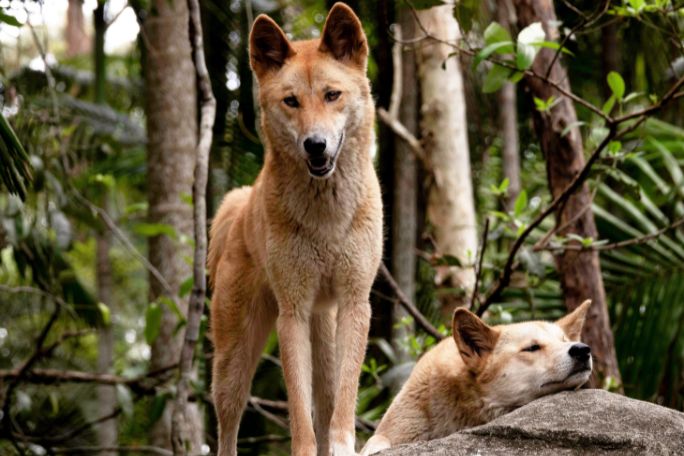Lesson summary
Native Australian fauna is intrinsically linked to the unique and specific conditions of the landscapes in which they spent centuries evolving and adapting. Bushfires dramatically alter those habitats. The challenge for scientists such as Mark Lintermans is not only to restore these habitats in the wake of a bushfire but to recreate the habitats to temporarily house some species and ensure their survival.
Students will study the impact of bushfires on the habitats and way of life of species that call them home before applying this understanding in the creation of a temporary habitat to relocate and captively breed species threatened by bushfires.
Learning intentions:
Students will...
- understand the impact of bushfires on the Australian landscape, flora, and fauna
- understand the work scientists are undertaking to protect and preserve the Australian landscape, flora, and fauna in the wake of bushfires
- understand the variety of ways fauna depend on their habitat for survival.
Success criteria:
Students can...
- conduct independent research
- identify ways in which the survival of species of native fauna has been threatened by the impact of bushfires on their habitats
- think critically and creatively to apply human intervention to assist fauna in surviving bushfires by designing artificial habitats conducive to their survival, as well as other interventions.
Lesson guides and printables
Lesson details
Curriculum mapping
Australian Curriculum content descriptions:
Years 6 Science:
- The growth and survival of living things are affected by physical conditions of their environment (ACSSU094)
- Sudden geological changes and extreme weather events can affect Earth’s surface (ACSSU096)
- Scientific knowledge is used to solve problems and inform personal and community decisions (ACSHE100)
Years 5 & 6 Visual Arts:
- Develop and apply techniques and processes when making their artworks (ACAVAM115)
- Plan the display of artworks to enhance their meaning for an audience (ACAVAM116)
Syllabus outcomes: VAS3.2, VAS3.1, ST3-11LW, ST3-9ES, ST3-7PW
General capabilities: Literacy, Critical and Creative Thinking
Cross-curriculum priority: Sustainability
Relevant parts of Year 6 Science achievement standards: Students explain how natural events cause rapid change to Earth’s surface. They describe and predict the effect of environmental changes on individual living things. Students explain how scientific knowledge helps us to solve problems and inform decisions.
Relevant parts of Year 5 & 6 Visual Arts achievement standards: Students explain how ideas are represented in artworks they make and view. Students use visual conventions and visual arts practices to express a personal view in their artworks. They demonstrate different techniques and processes in planning and making artworks.
This lesson is part of the wider unit of work: Beyond the Bushfires – Primary
Time required: 95 mins
Level of teacher scaffolding: Medium – facilitate class discussion and support students in independent research
Resources required
- Art supplies – Coloured pencils and textas
- Article – The Conversation – Double trouble: this plucky little fish survived Black Summer, but there’s worse to come
- Article – The Conversation – Scientists find burnt, starving koalas weeks after the bushfires
- Carboard box such as a shoebox – one per student
- Coloured paper
- Device capable of independent research, such as an iPad or laptop – one per student
- Device capable of presenting a video to the class
- Gluesticks
- List of 119 species that scientists have recommended are in need of immediate intervention
- Scissors
- Student Worksheets – one copy per student
- Toothpicks
- White paper
- Whiteboard
Skills
This lesson is designed to build students’ competencies in the following skills:
- Communication
- Community engagement
- Creativity
- Critical thinking
- Enterprise
- Problem solving
Additional info
In partnership with The Conversation, the Beyond the Bushfires series brings the words of scientists who are actively involved in research and science communication into classrooms throughout Australia. Students will explore evidence-based research embedded in the context of real-world practice.
Additional thanks to the Ian Potter Foundation, John T Reid Charitable Trusts and The Myer Foundation, for generously supporting the development of these lessons.


Welcome back!
Don't have an account yet?
Log in with:
By signing up to Cool.org you consent and agree to Cool's privacy policy to
store, manage and process your personal information. To read more, please see
our privacy policy here(Opens in new tab).
Create your free Cool.org account.
Many of our resources are free, with an option to upgrade to Cool+ for premium content.
Already have an account?
Sign up with:
By signing up to Cool.org you consent and agree to Cool's privacy policy to
store, manage and process your personal information. To read more, please see
our privacy policy here(Opens in new tab).